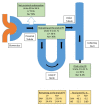New Approach to Hyponatremia: High Prevalence of Cerebral/Renal Salt Wasting, Identification of Natriuretic Protein That Causes Salt Wasting
- PMID: 36556061
- PMCID: PMC9786136
- DOI: 10.3390/jcm11247445
New Approach to Hyponatremia: High Prevalence of Cerebral/Renal Salt Wasting, Identification of Natriuretic Protein That Causes Salt Wasting
Abstract
Our understanding of hyponatremic conditions has undergone major alterations. There is a tendency to treat all patients with hyponatremia because of common subtle symptoms that include unsteady gait that lead to increased falls and bone fractures and can progress to mental confusion, irritability, seizures, coma and even death. We describe a new approach that is superior to the ineffectual volume approach. Determination of fractional excretion (FE) of urate has simplified the diagnosis of a reset osmostat, Addison's disease, edematous causes such as congestive heart failure, cirrhosis and nephrosis, volume depletion from extrarenal salt losses with normal renal tubular function and the difficult task of differentiating the syndrome of inappropriate secretion of antidiuretic hormone (SIADH) from cerebral/renal salt wasting (C/RSW). SIADH and C/RSW have identical clinical and laboratory parameters but have diametrically opposite therapeutic goals of water-restricting water-loaded patients with SIADH or administering salt water to dehydrated patients with C/RSW. In a study of nonedematous patients with hyponatremia, we utilized FEurate and response to isotonic saline infusions to differentiate SIADH from C/RSW. Twenty-four (38%) of 62 hyponatremic patients had C/RSW with 21 having no clinical evidence of cerebral disease to support our important proposal to change cerebral to renal salt wasting (RSW). Seventeen (27%) had SIADH and 19 (31%) had a reset osmostat. One each from hydrochlorothiazide and Addison's disease. We demonstrated natriuretic activity in the plasma of patients with neurosurgical and Alzheimer diseases (AD) in rat clearance studies and have now identified the natriuretic protein to be haptoglobin related protein without signal peptide (HPRWSP). We introduce a new syndrome of RSW in AD that needs further confirmation. Future studies intend to develop HPRWSP as a biomarker to simplify the diagnosis of RSW in hyponatremic and normonatremic patients and explore other clinical applications that can improve clinical outcomes.
Keywords: cerebral/renal salt wasting; fractional urate excretion; hyponatremia; natriuretic peptide.
Conflict of interest statement
Imbriano, Grant and Miyawaki declare no conflict of interest. Maesaka is a consultant to Otsuka Pharmaceutical US and part owner of SalAqua Diagnostics Inc.
Figures






References
Publication types
LinkOut - more resources
Full Text Sources

